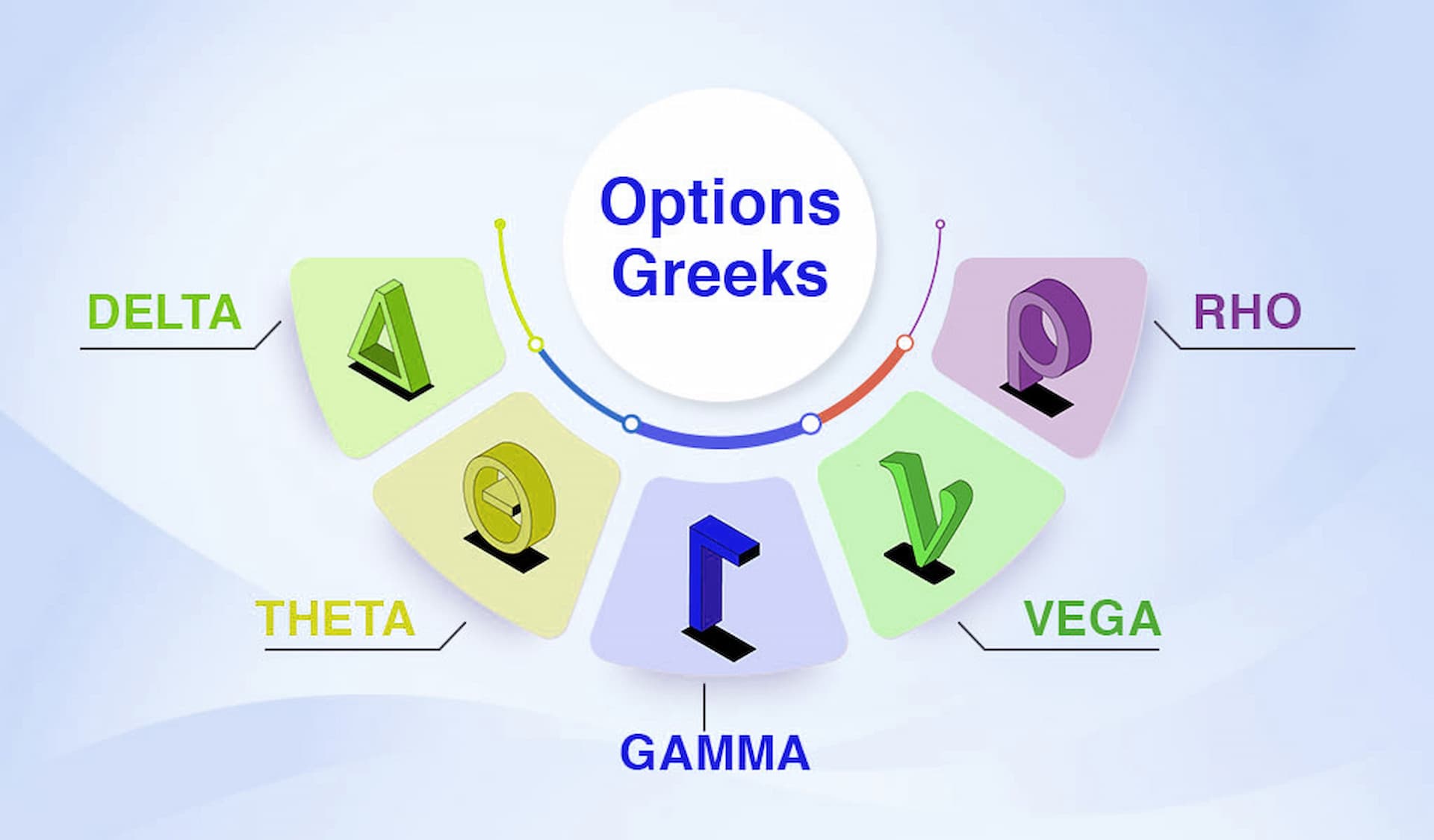Understanding and Implementing Options Greeks in Trading
This article provides a detailed analysis of the Options Greeks—Delta, Gamma, Theta, Vega, and Rho. It explains their definitions, significance, practical applications, and how traders can use these metrics to optimize their trading strategies and manage risks effectively.

1. Delta
Definition and Importance
Delta measures the sensitivity of an option’s price to changes in the price of the underlying asset. It represents the expected change in the option’s price for a $1 change in the price of the underlying asset.
-
Delta Values:
- Call Options: Delta ranges from 0 to 1. For example, a call option with a Delta of 0.6 means that the option’s price is expected to increase by $0.60 for every $1 increase in the price of the underlying asset.
- Put Options: Delta ranges from -1 to 0. A put option with a Delta of -0.7 means that the option’s price will decrease by $0.70 for every $1 increase in the price of the underlying asset.
- Call Options: Delta ranges from 0 to 1. For example, a call option with a Delta of 0.6 means that the option’s price is expected to increase by $0.60 for every $1 increase in the price of the underlying asset.
-
Usage:
- Hedging: Delta helps in creating a hedge against price movements in the underlying asset. For example, if you have a long position in a stock, you can use options to hedge against potential declines by taking a short position in a call option.
- Position Management: Maintaining a Delta-neutral position means balancing the Deltas of long and short positions to mitigate the impact of price movements in the underlying asset. This can be done through various strategies such as using options to offset the Delta of a stock position.
- Hedging: Delta helps in creating a hedge against price movements in the underlying asset. For example, if you have a long position in a stock, you can use options to hedge against potential declines by taking a short position in a call option.
-
Related Link: For a deeper understanding of Delta and its role in options trading.
2. Gamma
Definition and Importance
Gamma measures the rate of change of Delta with respect to changes in the underlying asset’s price. It indicates how Delta will change as the price of the underlying asset moves, providing insights into the stability of Delta.
-
Gamma Values:
- Positive Gamma: Typically associated with long options positions. A high positive Gamma means that Delta will increase as the price of the underlying asset increases, and decrease as the price decreases. This indicates that Delta becomes more sensitive to price changes as the asset’s price moves.
- Example: If a call option has a Gamma of 0.05, Delta will increase by 0.05 for every $1 increase in the price of the underlying asset.
- Example: If a call option has a Gamma of 0.05, Delta will increase by 0.05 for every $1 increase in the price of the underlying asset.
- Negative Gamma: Occurs in short options positions. It implies that as the underlying asset’s price rises, Delta decreases, and as it falls, Delta increases. This can increase the risk of large swings in the value of the position.
- Positive Gamma: Typically associated with long options positions. A high positive Gamma means that Delta will increase as the price of the underlying asset increases, and decrease as the price decreases. This indicates that Delta becomes more sensitive to price changes as the asset’s price moves.
-
Usage:
- Risk Management: Gamma helps in assessing the risk associated with Delta changes. High Gamma indicates that Delta can change rapidly, affecting the overall risk of the position. Traders often use Gamma to adjust their positions more frequently to manage risk.
- Dynamic Adjustments: Traders use Gamma to understand how frequently they need to adjust their positions to maintain a desired Delta or Delta-neutral stance.
- Risk Management: Gamma helps in assessing the risk associated with Delta changes. High Gamma indicates that Delta can change rapidly, affecting the overall risk of the position. Traders often use Gamma to adjust their positions more frequently to manage risk.
-
Related Link: Explore Gamma and its impact on options trading.
3. Theta
Definition and Importance
Theta measures the rate of time decay of an option’s price. It reflects how the value of an option decreases as it approaches its expiration date, highlighting the impact of time on the option's price.
-
Theta Values:
- Positive Theta: Seen in short options positions. It means that the value of the option decreases as the expiration date approaches, benefiting the seller of the option. For example, a Theta of -0.05 means the option will lose $0.05 in value each day as it nears expiration.
- Negative Theta: Seen in long options positions. It implies that the option’s value will decrease over time, which can be a disadvantage for the buyer of the option.
- Positive Theta: Seen in short options positions. It means that the value of the option decreases as the expiration date approaches, benefiting the seller of the option. For example, a Theta of -0.05 means the option will lose $0.05 in value each day as it nears expiration.
-
Usage:
- Time Decay Management: Theta helps traders understand how much value an option will lose each day as it approaches expiration. This is crucial for selecting strategies that either benefit from or mitigate the effects of time decay.
- Strategy Selection: Traders use Theta to choose strategies that align with their views on time decay. For example, selling options can be profitable if Theta is high, while buying options might be preferred if Theta is low.
- Time Decay Management: Theta helps traders understand how much value an option will lose each day as it approaches expiration. This is crucial for selecting strategies that either benefit from or mitigate the effects of time decay.
-
Related Link: Discover more about Theta and its impact on time decay.
4. Vega
Definition and Importance
Vega measures an option’s sensitivity to changes in the volatility of the underlying asset. It shows how much the price of an option will change for a 1% change in implied volatility.
-
Vega Values:
- Positive Vega: Common in long options positions. It means that the price of the option increases with an increase in volatility. For example, a Vega of 0.10 indicates that the option’s price will increase by $0.10 for every 1% increase in implied volatility.
- Negative Vega: Common in short options positions. It implies that the option’s price decreases as volatility rises.
- Positive Vega: Common in long options positions. It means that the price of the option increases with an increase in volatility. For example, a Vega of 0.10 indicates that the option’s price will increase by $0.10 for every 1% increase in implied volatility.
-
Usage:
- Volatility Trading: Vega helps traders make decisions based on expected changes in market volatility. If a trader anticipates an increase in volatility, they might buy options to benefit from higher Vega.
- Risk Management: Traders use Vega to manage the risk associated with changes in implied volatility, adjusting their positions as needed to account for expected volatility shifts.
- Volatility Trading: Vega helps traders make decisions based on expected changes in market volatility. If a trader anticipates an increase in volatility, they might buy options to benefit from higher Vega.
-
Related Link: Learn more about Vega and its role in trading volatility.
5. Rho
Definition and Importance
Rho measures an option’s sensitivity to changes in interest rates. It shows how much the price of an option will change for a 1% change in interest rates.
-
Rho Values:
- Positive Rho: Seen in long call options. It indicates that the price of the option increases with an increase in interest rates. For example, a Rho of 0.05 means the option’s price will increase by $0.05 for every 1% increase in interest rates.
- Negative Rho: Seen in long put options. It signifies that the price of the option decreases with an increase in interest rates.
- Positive Rho: Seen in long call options. It indicates that the price of the option increases with an increase in interest rates. For example, a Rho of 0.05 means the option’s price will increase by $0.05 for every 1% increase in interest rates.
-
Usage:
- Interest Rate Forecasting: Rho helps traders evaluate the impact of expected changes in interest rates on their options positions. Understanding Rho allows traders to adjust their strategies based on anticipated interest rate movements.
- Strategic Adjustments: Traders use Rho to make adjustments to their positions in response to interest rate changes, optimizing their trading outcomes and risk management.
- Interest Rate Forecasting: Rho helps traders evaluate the impact of expected changes in interest rates on their options positions. Understanding Rho allows traders to adjust their strategies based on anticipated interest rate movements.
-
Related Link: Explore Rho and its effect on options pricing.
Conclusion
Understanding and applying the Options Greeks—Delta, Gamma, Theta, Vega, and Rho—are crucial for any trader involved in options trading. Each Greek provides unique insights into how various factors impact the pricing and risk profile of options. By leveraging these metrics, traders can better manage their positions, assess risks, and develop more effective trading strategies.
TAGS
Latest Education Articles
Show more
Earnings Reports and Equity CFDs

Trend vs. Range Strategies

Trading Breakouts vs. Pullbacks

Hedging Basics for Intermediate Traders
Take your trading to the next level.
Join the broker built for global success in just 3 easy steps. A seamless experience built for traders who value speed and simplicity.

Create Your Account

Make Your First deposit
